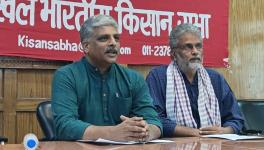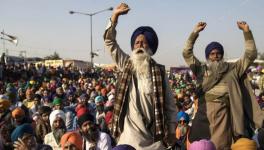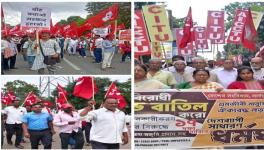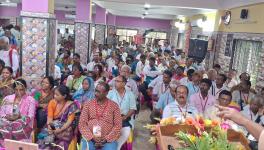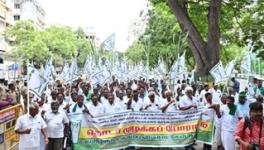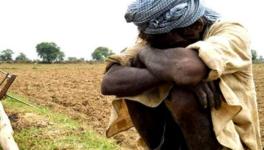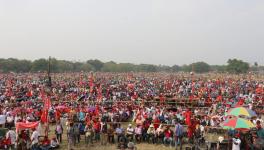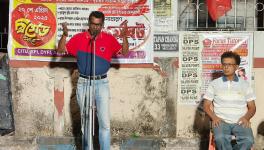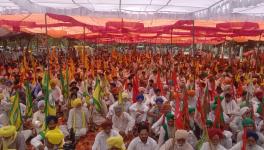Historic Farmer’s Protest, Participation of Women Farmers And Women’s Question in India
India has seen year-long historic farmer’s protest demanding repeal of three farm laws and this persistent struggle effectively became victorious with the Government repealing the laws in Parliament. However, this came with 700 odd farmers becoming martyrs in the path of struggle. This struggle in its path revealed much more than what it intended. Images of the struggle in media always were marked with the vibrant presence of women farmers in the movement. Women farmers are invisible in Indian official statistics as one of the major contributors to agricultural production. But any narration of the struggle cannot leave them out. From the beginning of the struggle women farmers from the rural fields of Punjab, Haryana and Uttar Pradesh dominated the battlefield of protest. This markedly changed the narrative of a democratic movement in the country and the women’s question.
WOMEN FARMERS NOT RECOGNISED IN DATA
Non-recognition of women’s work in all urban and rural activities is prevalent and well-known. It is always assumed that all of this work, particularly farm work in agriculture is work under household work, leaving most women unrecognised. But the number of women workers in agriculture exceeds all other categories. According to the Periodic Labour Force Survey (2019-20), rural women working in agriculture formed 75.7% of rural women. Majority of them work in their own fields, while men migrate to urban areas in search of jobs. The situation is slightly different in northern states, where the high requirement of labour in the agricultural fields compel most of the women to do all the work in the field and women are also engaged as agricultural labourers. Census of India defines ‘cultivators’ as farmers who operate on a piece of agricultural land. This means those who cultivate their own land or possesses their own land rights are enumerated as ‘farmers’. Women fail to satisfy this definition and fail to make an entry to be recognised ‘farmer’ in Indian official statistics.
There were 3.6 crore women cultivators in the 2011 Census. Oxfam India Policy Brief Report in 2013 stated that 75% of full-time farm labour is that of women. There is also unpaid farm labour performed by women. The gender gap in land ownership in 2018 was found to be substantial in a report by the National Council of Applied Economic Research. Women workers comprise 42% of the workforce in agriculture while they own less than 2% of agricultural land. People’s Archive of Rural India (PARI) showed that two-thirds of the female workforce work in agriculture. Between 1995 and 2018, 50,188 suicides of female farmers were reported by National Crime Records Bureau. This accounts for 14.82% of total farmer’s suicides. Most of them are single women, either widowed by suicides of male farmers or left single to manage the fields. Incidence of suicides was mostly found among landless, small and marginal farmers.
CHALLENGED PATRIARCHY
Popular media and state authority painted them as farmer’s daughters, wives and mothers but their active participation established their close bonds with land and agriculture. They themselves held microphones and burst out slogans against corporate hijacking of agriculture in the country. They were stakeholders and it was possible due to the reality of women in agriculture which was long ignored in state policies.
The historic farmer’s protest movement at Tikri, Singhu, and Ghazipur border exploded with women farmers coming out in public with statements like, “We grow food along with men, we are not going to give up our right over our produce to corporates Adani and Ambani even if the Prime Minister thinks so.” Thousands and thousands of women farmers gathered at the borders from the northern states and each day the numbers increased. They were markedly visible in the struggle.
This is not a new phenomenon. Women farmers also dominated the protest march in All India Kisan Sabha’s march from Nasik to Mumbai in 2018 in Maharashtra. They were already speaking up and making us recall the history of peasants’ struggle in colonial India - Tebhaga and Telangana - which also saw huge women’s participation. In the protest by Sanyukta Kisan Morcha (SKM) against the three farm laws in accordance with the dictates of the World Trade Organisation, women farmers proved again how much they care for the nation’s cause. Not denying that they were mothers, daughters, wives of farmers, and caregivers in families, their status of stakeholders in the struggle was crystal clear.
Women’s participation in farmer’s protests was ridiculed by the patriarchal capitalist state when even the then Chief Justice of India SA Bobde made the statement “Why are women kept in protest”? SKM released a statement just one year ago where they clearly stated that the contribution of women in agriculture was incomparable and the movement was a movement of women. They strongly condemned the questioning of women’s agency in the movement. Women were leading the movement from the front. They were going back to villages, taking care of home and agricultural fields as well as organising the struggle in the rural areas. When they marched to the protest sites each day, they marched with men and women from the rural fields of Punjab, Haryana, Uttarakhand, Uttar Pradesh, Gujarat. Later farmers from all parts of the country joined. They were well aware of the three laws and they spoke strongly before all media that the first blow of giving away their earnings will be on the kitchen.
MOBILISATION ACROSS THE COUNTRY
Women protesters had a huge impact on urban women in white-collared jobs, students and professionals. This influence on the lives of women in other fields of life helped women’s struggle in the country to uphold the agenda of women’s liberation. The protest effectively achieved gender-class unity and solidarity in the women’s movement. Only the old and children were kept back in the villages and women had a rotating duty of going back to the villages and coming back to take care of the people and the livestock. But when they went back they held meetings in the villages, organised and spread the struggle and marched back with more and more people from the villages. Some of their children stayed with their mothers in the camps.
Punjab also saw an increase in peasant suicides in recent years with the rising indebtedness of farmers due to the high increase in the cost of cultivation. The Minimum Support Price (MSP) for the crops was a demand which the women raised for survival. They clearly pointed their finger at corporate loot of national wealth. This demand came from their personal stake. The allegation that women do not understand the political slogans and joined men as part of their family was in the air from the beginning of the struggle. This is the version of the corporate-led statist view of women in our country. This is an attempt to depoliticise women’s struggle in rural India. The movement gained solidarity from across the country which falsified all these statements within a short time.
The farm reform acts which were repealed in Parliament, marketing was in the hands of corporate leaders bypassing the earlier Agricultural Produce Market Committee Act. This would have affected women adversely as rural women cannot avail themselves of the opportunity of infrastructure with their restricted mobility. Women would also have been pushed to a more vulnerable position with low bargaining power with the initiation of contract farming.
Women felt personal stakes in the Bill which they forced the government to withdraw. According to the protesters, when the state and society do not understand, there is a need for such protests to force the state to amend. Women farmers were already opined against agribusiness and the protest was spontaneous in a way. As the protest grew, questions and critiques regarding the participation of women also receded. More and more women from all fields poured in to show solidarity.
SHAKING WOMEN’S MOVEMENT
Will the protest and repeal of the three farm laws bring any change in women’s lives? This is the question hanging on at the end of the struggle. The protest has not ended in principle. SKM is awaiting more changes from the state policy. But year-long protests and massive women’s participation brought to the centre stage some issues of women’s liberation. Coming from the land which witnessed khap panchayats acting against the choices of women, the class protest moved into a joint camp where women were giving speeches, dictating terms of the movement and organising people.
Was this political empowerment coming through a class struggle? The makeshift library was there in protest sites and both men and women read books, formed opinions, discussed the struggle. From a state earmarked for falling juvenile sex ratio, women came, sang, danced and performed cultural programmes of their own choice and none prevented them. When the laws were repealed in Parliament and they were returning home, public rejoicing of women through song and dance on the road together with men folks was unheard, unseen earlier. Did one hear of caste segregation in the movement? Gender-caste segregation also went away in the last year of the movement. Sharing of food in the same kitchen and eating together drove away all such differences. “When the families were returning after the struggle, they shook patriarchy from the movement and changed families that were returning,” said Savitha of the All India Democratic Women’s Association in Haryana who was in the struggle. At least in the last year of the movement women were leaving in a new space of empowerment, which was the gift of land struggle, class struggle against the hegemony of corporate capitalism. The struggle changed the mindset as all were united in the struggle as their goal was so well-defined. Could this have any impact on the rural society of the participating states? Could this have any impact on the women’s movement for liberation and equality in the country? These are awaiting us in the future course.
DISCUSSION INITIATED BY INDIAN ASSOCIATION FOR WOMEN’S STUDIES
Indian Association for Women’s Studies, Feminist Policy Collective, and Mahila Kisan Adhikar Manch organiSed a day-long webinar on October 21, 2021, on ‘Transformative Financing and Women in Agriculture in India’. Utsa Patnaik delivered the keynote of the webinar where she explained the deepening agrarian crisis and the World Trade Organisation’s mandate, which brought misery to rural households. Women were undoubtedly victims of this crisis. Discussions were made by P Sainath, Ravi Srivastava, P Ramakumar, Navsharon Singh, Sejal Dand, Soma Parthasarathy and others with Madhura Swaminathan adding closing remarks. The event was following the International Day of Rural Women observed on October 15. Transformative financing requires more gender-sensitive practices in the financing of development to be inclusive. Doesn’t that include women in agriculture? Farmer’s protest provided an answer to this.
The webinar questioned the control over markets by corporates which delegitimised women’s choices over traditional production and local markets and small circuit markets. This policy as designed would have also affected sharecropping decisions. As the laws meant a complete reversal in agricultural rights, whatever meagre was there the protests saw unprecedented international solidarity. Women farmers were politically embedded in the deep agrarian crisis prevailing in the country. Hence it is through the exercise of their political rights alone which meant empowerment through accessing their rights. Even Dalit women were leaders in the movement.
There was already a mobilisation preceding the struggle where women were beginning to take part in agrarian movements. Women farmers were beginning to recognise that political struggle is the only alternative left to claim their rights. Following this discussion, the Indian Association for Women’s Studies and the Indian Society of Agricultural Economics in its Annual Conference organised a panel discussion on ‘Agrarian distress, farmer’s protest and the question of women farmers’ on December 2. The panel was chaired by Abhijit Sen and addressed by researchers and academics like Mahendra Dev, Navsharon Singh and Savitha. The struggle of women farmers was put in the backdrop of the plight of the women farmers in the country.
POLICY ON WOMEN IN AGRICULTURE
Problems of women in agriculture persisted for long in India. The situation aggravated with the agrarian crisis. National Commission of Women in 2009 prepared a Draft National Policy for Women in Agriculture and submitted it to the Ministry of Agriculture with a recommendation to adopt it. This came out from the Report of the National Commission of Farmers in 2008. This is a time to take a renewed look into the Policy Paper as the right to recognition of women farmers, right over land including forest land, freedom from debt and right to regulated markets have been raised to new heights now.
It is now yet to be seen in future how the women’s movement nurtures itself and makes a forward move reaping the gains from women farmers’ struggle. Patriarchy is nourished by a capitalist corporate system that controls state and policy. Farmer’s struggle revealed that only united class struggle can retaliate and lead the way to women’s equality. The question is when women are returning back from year-long struggle will they meet a changed socio-economic environment and norms in the village or there will be revert back to earlier forms of patriarchy. The question is how far women’s leadership in the movement can shake women’s movement for equality in the country, or the solidarity gradually fades away. The movement has gone beyond the target and has hit the political, social and economic mesh of the country. It is to wait and see the criticality of the mass of the movement as mover and shaker in Indian gender politics.
The author is a professor at the Department of Economics, University of Calcutta and also President of the Indian Association for Women’s Studies. Views are personal.
Get the latest reports & analysis with people's perspective on Protests, movements & deep analytical videos, discussions of the current affairs in your Telegram app. Subscribe to NewsClick's Telegram channel & get Real-Time updates on stories, as they get published on our website.










